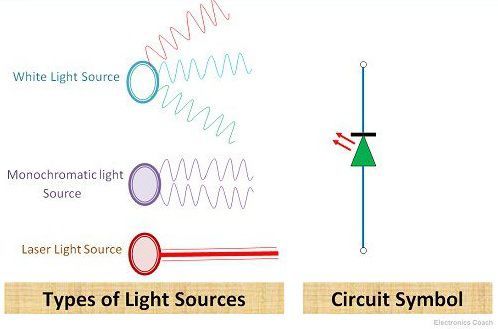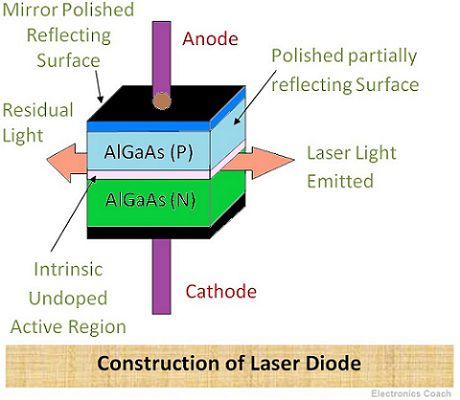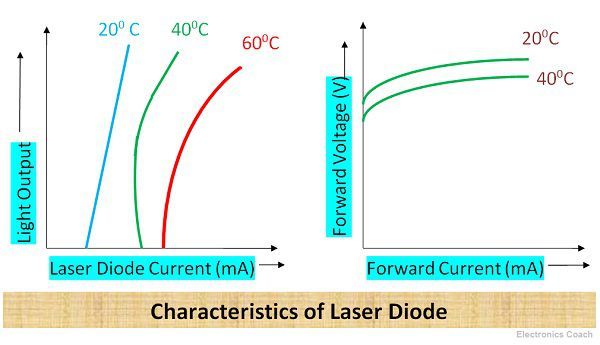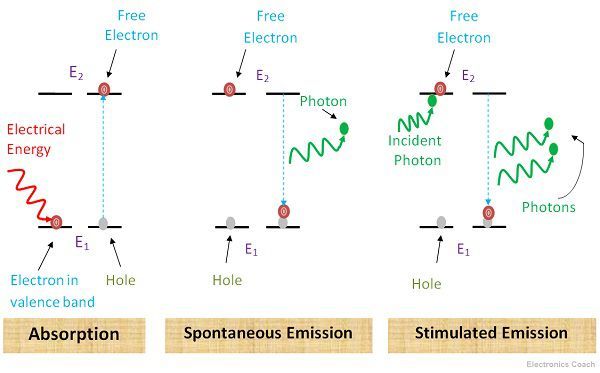Definition: LASER is an acronym of Light amplification by stimulated emission of radiation. A laser diode emits radiation of a single wavelength or sometimes a narrow band of closely spaced wavelength.
It emits light due to stimulated emission, in this when an incident photon strike semiconductor atom, the electrons at higher energy level recombine with lower energy level hole. Due to this two photons are emitted one incident photon and other is emitted due to recombination of electrons and hole.
LEDs also work on the same principle but the major difference is the internal architecture. A laser diode is formed from narrow channels and it acts as a waveguide for light. But LEDs is made up of wide channels.

Due to its structure Laser diode emits coherent & monochromatic light (Single colour). The light emitted by Laser diode consists of single wavelength while LEDs emit light consisting of a wide band of wavelengths. Thus, the light emitted by LED is incoherent.
Construction of Laser diode
The Laser diode is made up of two layers of Semiconductors i.e. P-type and N-type. The layers of semiconductors are made up of GaAs doped with materials like selenium, aluminium or silicon. The construction is same as that of LED except the channels used in Laser are narrow to produce a single beam of light.

And one more difference in a Laser diode is that an intrinsic layer of GaAs (undoped) is also present. This layer is called active layer. The active layer is enclosed by layers of lower refractive index. This act as optical reflectors.
These layers along with active layer form a waveguide so that light can travel only in a single path in a single and fixed direction. The beam of light is produced in this section. The metal contacts are provided to facilitate biasing.
Working of Laser diode
The laser diode works on the principle that every atom in its excited state can emit photons if electrons at higher energy level are provided with an external source of energy.

There are basically three phenomena by which an atom can emit light energy and that are Absorption, Spontaneous Emission & Stimulated emission.
Absorption
In absorption, the electrons at lower energy levels jump to higher energy level i.e. from valence band to conduction band when the electrons are provided with an external source of energy. Now, there are holes at lower energy level i.e. valence band and electrons at higher energy level i.e. conduction band.
Spontaneous Emission
Now, if the electrons in higher energy level are unstable then they will tend to move to the lower energy level in order to achieve stability. But if they will move from higher energy level to lower energy levels they will definitely release the energy which will be the energy difference between these two levels. The energy released will be in the form of light and thus photons will be emitted. This process is called spontaneous emission.
Stimulated Emission
In stimulated emission, the photons strike electrons at higher energy level and these photons are supplied from an external light energy source. When these photons strike the electrons, electrons gain energy and they recombine with holes and release an extra photon. Thus, one incident photon stimulates another photon to release. Thus, this process is called stimulated emission.
Population inversion
The density of electrons at energy levels is the population of electrons and it is more in valence band or lower energy band and less in the conduction band or higher energy level. If the population of electrons increases at higher energy level or the lifetime of higher energy states is long then stimulated emission will increase. This increase of population at higher energy level is termed as population inversion.
And this is the requisite state for Laser diode. More the population inversion more will be the electrons at higher and meta stable state and more will be the stimulated emission. The photons emitted are in the same phase with the incident photons. And these photons travel as a single beam of light and thus produce coherence.
Major Categories of Laser Diode
There are two major categories of Laser Diode i.e. Injection Laser Diode & Optically Pumped semiconductor laser diode.
- Injection laser diode: The operation is similar to LED except that LEDs are formed by wide channels of Semiconductor while Laser diodes are formed from narrow channels. We have already discussed this in the construction of Laser Diode. In this, the light beam travels in the waveguide and the diode itself acts as a waveguide. The light beam is amplified by repeated stimulated emission.
- Optically Pumped Semiconductor Laser: In optically pumped laser the injection laser diode acts as an external pump. The III & V group semiconductor materials act as a basis. And the amplification is achieved by stimulated emission.
It offers several advantages such as prevention from interference caused due to the electrode structure. Besides, it also provides an advantage of wavelength selection.
Laser Diode L-I Characteristics
The light energy increases with increase in laser current but it is dependent on temperature. It is evident from the curve that the light energy increases after a particular threshold laser current. This threshold value of laser current increases exponentially with the temperature.
Thus, at a higher temperature, the threshold value of laser current up to which light energy is generated, also increases. Thus, it is necessary to operate the laser diode up to threshold value of laser current because above this value there is no light energy. In order to have a reliable operation, it is necessary to determine the threshold value of laser current.
V-I Characteristics of Laser diode
The forward voltage of laser diode is generally around 1.5 V. Although the forward voltage depends on operating temperature. The variance of current in the diode with the voltage can be understood with the help of below diagram.

Advantages of Laser Diode
- Low power Consumption device.
- Economical as its cost of manufacturing and operation is low.
- It can be operated for a long time.
- Portable due to its small size and internal architecture.
- Highly reliable and highly efficient.
Disadvantages of Laser Diode
- These are temperature dependent and thus its operation is affected by the change in operating temperature.
- It is not suitable for high power application.
Applications of Laser diode
- Fibre optical communication system.
- Barcode readers.
- Laser Printing and laser scanning.
- Rangefinders.
- In medical fields in surgical instruments.
- In CD players and DVD recorder.
These are some of the significant applications of the LASER diode. Amongst all of these applications the most crucial realm in which laser diode finds its application is optical fibre communication system.

Leave a Reply